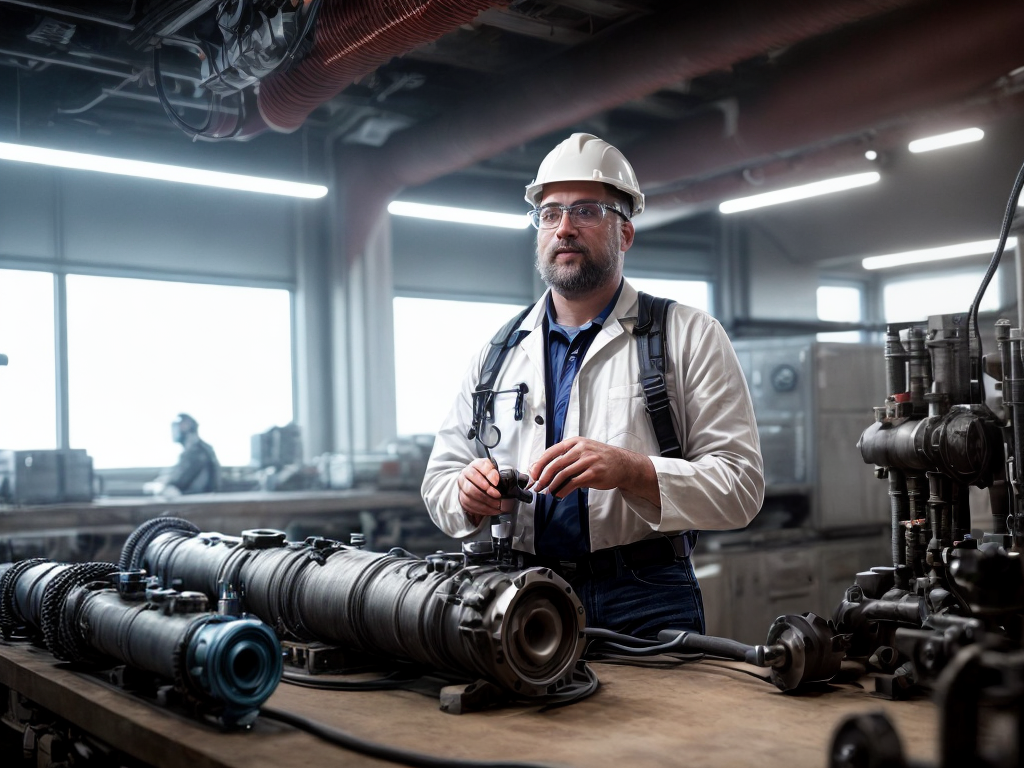
As a valve design engineer, I have witnessed firsthand the ever-evolving landscape of this industry, where trends and challenges constantly shape the way we approach our work. From the emergence of new technologies to the growing demand for sustainability, there is no shortage of factors driving innovation and pushing us to push the boundaries of what is possible. In this interview, I will delve into the trends and challenges that define the world of valve design, shedding light on the innovations that are shaping its future and the obstacles we face along the way. So, join me as we explore the dynamic world of valve engineering and uncover the exciting possibilities that lie ahead.
The Role of a Valve Design Engineer
As a Valve Design Engineer, my role involves designing and developing efficient and reliable valves for various industrial applications. The design process is a crucial aspect of my job, as it encompasses everything from conceptualization to prototyping and final production. I follow industry standards and guidelines to ensure that the valves I design meet the highest quality and safety standards.
The design process begins with gathering requirements and understanding the specific needs of the client or application. This involves conducting extensive research and analysis to identify the key parameters and performance criteria that the valve must meet. Once the requirements are established, I move on to conceptualizing the valve design, considering factors such as size, materials, and operating conditions.
Using computer-aided design (CAD) software, I create detailed 3D models of the valve, taking into account factors like flow characteristics, pressure ratings, and temperature limitations. Simulation tools are then employed to analyze the performance of the valve under different operating conditions, ensuring its reliability and efficiency.
Once the design is finalized, I work closely with the manufacturing team to ensure that the valve is produced to the highest standards. This involves conducting regular inspections and quality control checks throughout the production process.
Emerging Technologies in Valve Design
What are some emerging technologies shaping the future of valve design? One of the most significant advancements in valve design is the development of smart valves. These valves are equipped with advanced sensors and actuators that allow them to autonomously monitor and control the flow of fluids. By incorporating smart technology, these valves can detect changes in pressure, temperature, and flow rate, and adjust their operations accordingly. This not only improves the efficiency and reliability of the valves but also enables proactive maintenance and troubleshooting.
Another area of emerging technology in valve design is automation advancements. Automation has revolutionized various industries, and valve design is no exception. With the integration of automation systems, valves can be remotely controlled and monitored, eliminating the need for manual operation. This not only increases the accuracy and precision of valve operations but also enhances safety by reducing human error.
Furthermore, automation advancements have led to the development of intelligent control systems that can optimize valve performance based on real-time data and predictive analytics. These systems can analyze historical data, identify patterns, and make informed decisions to optimize valve settings for maximum efficiency and reliability.
Meeting the Demand for Sustainability
With the increasing focus on sustainability, valve design is evolving to meet the demand for more environmentally friendly solutions. As a valve design engineer, I am constantly looking for ways to incorporate sustainable materials and promote a circular economy. Here are four key trends and challenges in meeting the demand for sustainability in valve design:
-
Material Selection: Choosing sustainable materials is crucial in reducing the environmental impact of valves. By opting for materials that are renewable, recyclable, and have a low carbon footprint, we can minimize waste and energy consumption during production and disposal.
-
Lifecycle Assessment: Conducting a thorough lifecycle assessment helps us understand the environmental impact of valves throughout their entire lifespan. By analyzing factors like raw material extraction, manufacturing processes, transportation, and end-of-life disposal, we can identify areas for improvement and make informed design decisions.
-
Energy Efficiency: Enhancing the energy efficiency of valves is essential for reducing greenhouse gas emissions. By designing valves with improved sealing mechanisms, reduced leakage, and optimized flow characteristics, we can minimize energy losses and improve overall system performance.
-
Circular Economy: Embracing the principles of a circular economy is becoming increasingly important in valve design. By implementing strategies like remanufacturing, refurbishing, and recycling, we can extend the lifespan of valves and reduce the need for new production, thus conserving resources and reducing waste.
Challenges in Valve Engineering
Valve engineering presents a multitude of challenges that require innovative solutions and technical expertise. As a valve design engineer, I constantly face these challenges and strive to overcome them to create efficient and reliable valve systems. Two significant challenges in valve engineering are advancements in valve materials and overcoming valve design limitations.
Advancements in valve materials have revolutionized the field of valve engineering. With the development of new materials, such as ceramics and composites, valves can now withstand extreme temperatures, corrosive environments, and high pressures. These materials offer improved durability, longevity, and performance, making them ideal for various industries, including oil and gas, chemical, and power generation.
However, incorporating these advanced materials into valve designs comes with its own set of challenges. The compatibility between materials, their thermal expansion coefficients, and their ability to withstand mechanical stress must be carefully considered during the design process. Additionally, the manufacturing and fabrication techniques for these materials require expertise and precision to ensure the valves meet the required specifications and standards.
Another challenge in valve engineering is overcoming design limitations. Valves must meet specific performance criteria, such as flow control, pressure regulation, and leakage prevention. Designing valves that can handle high flow rates, extreme pressures, and aggressive media requires careful consideration of factors such as valve geometry, sealing mechanisms, and actuation systems. Additionally, valve design must also consider factors like space constraints, weight limitations, and ease of maintenance.
To overcome these challenges, valve design engineers utilize advanced modeling and simulation techniques, conduct extensive testing and prototyping, and collaborate with materials scientists and other experts. By continuously pushing the boundaries of innovation and leveraging technical expertise, valve engineers strive to develop valves that meet the ever-evolving demands of various industries.
Innovations Driving the Industry Forward
Innovations in valve engineering have propelled the industry forward, revolutionizing the way we design and manufacture valve systems. Here are four key innovations that are driving the industry towards smart manufacturing and digital transformation:
-
Advanced Materials: The development of new materials with enhanced properties has opened up new possibilities for valve design. Lightweight and corrosion-resistant materials like titanium alloys and composites are replacing traditional materials, improving the overall performance and longevity of valve systems.
-
Internet of Things (IoT) Integration: By incorporating IoT technology into valves, we can now gather real-time data on valve performance, allowing for predictive maintenance and optimizing operational efficiency. IoT integration also enables remote monitoring and control, reducing downtime and increasing productivity.
-
Digital Twins: Digital twins are virtual replicas of physical valves that simulate their behavior in real-world conditions. By creating digital twins, engineers can analyze performance, test different scenarios, and optimize valve designs without the need for physical prototypes, saving time and resources.
-
Automation and Robotics: The use of automation and robotics in valve manufacturing has significantly increased efficiency and precision. With automated processes, tasks that were once labor-intensive and time-consuming can now be done quickly and accurately, improving productivity and reducing costs.
These innovations are reshaping the valve industry, allowing for smarter, more efficient, and cost-effective valve systems. As we continue to embrace smart manufacturing and digital transformation, the possibilities for further innovation and improvement are endless.
Future Trends in Valve Design
As the valve industry continues to evolve, new trends are emerging that will shape the future of valve design. One of the key trends is the adoption of smart valve technology, which integrates digitalization into valves to improve functionality and efficiency. This technology allows valves to collect and transmit real-time data, enabling better monitoring and control of valve operations.
To illustrate the potential impact of smart valve technology, let’s examine a table highlighting some of its key features and benefits:
| Feature | Benefits |
|---|---|
| Remote monitoring | Allows for real-time data collection and analysis, enabling proactive maintenance and troubleshooting. |
| Condition monitoring | Provides insights into valve performance, allowing for predictive maintenance and reducing downtime. |
| Control optimization | Enables precise control of valve operations, leading to improved process efficiency and energy savings. |
| Enhanced safety | Alerts operators to potential issues or abnormal conditions, enhancing safety and preventing accidents. |
The digitalization of valves not only improves their performance but also opens up new possibilities for integration with other systems, such as process control and asset management software. This integration allows for seamless communication and coordination between valves and other components, further optimizing industrial processes.
As we move towards a more connected and automated future, the integration of smart valve technology and digitalization in valves will play a crucial role in enhancing productivity, reliability, and safety in various industries. By harnessing the power of data and advanced control capabilities, valve design will continue to evolve, meeting the increasing demands of modern industrial applications.


